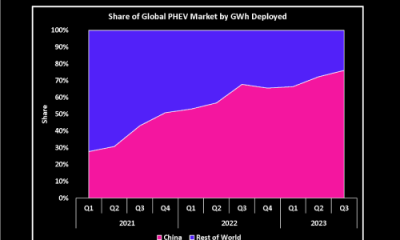Energy & Critical Metals
Polestar Looks Considerably Cheaper Than Rivals Lucid and Rivian
Many U.S. and Canadian risk-tolerant investors who want exposure to start-up, non-China-based manufacturers of electric vehicles (EV) have gravitated to
The…

Many U.S. and Canadian risk-tolerant investors who want exposure to start-up, non-China-based manufacturers of electric vehicles (EV) have gravitated to two well-known companies: Lucid Group, Inc. (NASDAQ: LCID) and Rivian Automotive, Inc. (NASDAQ: RIVN). Another, actually more established EV maker, Polestar Automotive Holding UK PLC (NASDAQ: PSNY), may represent better value than either company.
Based in Sweden, Polestar currently has produced three premium EV models: Polestar 1, a hybrid, high-performance car; Polestar 2, a high-volume, fully electric vehicle (US$50,000-US$70,000 price); and Polestar 3, an electric SUV which debuted in October 2022 (US$80,000-US$120,000 price). Polestar was founded by Volvo and Geely, a Chinese automaker. Importantly, Polestar has contract manufacturing and supply and service agreements with its founding companies. In particular, one pact allows Polestar to utilize Volvo Cars’ existing distribution process in the United States.

In September 2021, Polestar and the SPAC sponsor Gores Guggenheim, Inc. entered into a definitive business combination. The merger was completed in June 2022, at which time Polestar began trading under the symbol PSNY on the NASDAQ.
The table below itemizes some of the key financial and operating characteristics of Polestar, Lucid and Rivian.
SELECTED FINANCIAL OPERATING AND FINANCIAL STATISTICS OF LEADING EV MAKERS
| (in millions of U.S. dollars, except vehicles delivered, share price, and shares outstanding) | Polestar | Lucid | Rivian |
| Revenue | $1,477 | $350 | $995 |
| Cost of Sales | ($1,419) | ($1,031) | ($3,118) |
| Gross Profit | $57 | ($680) | ($2,123) |
| Operating Expenses – Continuing Operations | $767 | $1,164 | $2,938 |
| Operating Income – Continuing Operations | ($709) | ($1,844) | ($5,061) |
| Operating Cash Flow | ($1,023) | ($1,578) | ($3,606) |
| Capital Expenditures | ($653) | ($785) | ($1,075) |
| Adjusted EBITDA | ($569) | ($1,351) | ($3,756) |
| Vehicles Delivered | 30,424 | 2,437 | 12,278 |
| Share Price | $7.91 | $10.23 | $29.69 |
| Shares Outstanding (millions) | 2,109 | 1,681 | 921 |
| Stock Market Capitalization | $16,685 | $17,197 | $27,344 |
| Cash | $988 | $3,342 | $13,272 |
| Debt | $1,256 | $2,070 | $1,761 |
| Enterprise Value | $16,953 | $15,924 | $15,833 |
| Enterprise Value/Revenue Over First Nine Months of 2022 | 11.5 | 45.4 | 15.9 |
The three EV makers have roughly similar enterprise values ranging from US$15.8 billion for Rivian to US$17.0 billion for Polestar, yet Polestar’s current profitability and cash flow profile is far superior to both Lucid and Rivian. Specifically, Polestar has generated a gross profit (revenue less cost of sales) of positive US$57 million over the first nine months of 2022; while Lucid and Rivian have posted gross profits of negative US$680 million and negative US$2.1 billion, respectively, over the same period.
Similarly, Polestar has burned considerably less cash so far in 2022 than either Lucid or Rivian. Polestar’s operating cash flow deficit over the first nine months of 2022 is around US$1.0 billion versus US$1.6 billion for Lucid and US$3.6 billion for Rivian.
Given that all three companies currently generate negative cash flow, one cannot compare the stocks’ cash flow multiples. In terms of enterprise value to revenue over the first three quarters of 2022, Polestar’s valuation (11.5x) is noticeably cheaper than Rivian (15.9x), and markedly less expensive than Lucid (45.4x).
Operationally, Polestar has delivered to customers about twice as many vehicles over the first three quarters of 2022 (30,424) than Lucid and Rivian combined (2,437 for Lucid and 12,278 for Rivian).
One area where Rivian has an advantage over Polestar is the strength of its balance sheet. Its US$13.3 billion cash balance as of September 30, 2022 suggests it may not need to tap the capital markets for several quarters. Polestar (US$1.0 billion of cash as of the same date) could be forced to sell equity fairly soon, and Lucid (US$3.3 billion as of September 30, 2022) may already be selling new stock via a previously announced at-the-market issuance program.
In summary, Polestar may not necessarily be a cheap stock on an absolute basis. It faces many challenges, including the potential impact of an economic downturn. However, on many key measures, it looks like a cheaper EV investment than Lucid or Rivian.
Information for this briefing was found via Edgar and the sources mentioned. The author has no securities or affiliations related to this organization. Not a recommendation to buy or sell. Always do additional research and consult a professional before purchasing a security. The author holds no licenses.
The post Polestar Looks Considerably Cheaper Than Rivals Lucid and Rivian appeared first on the deep dive.

Uranium Exploration Company Announces Additional Staking in the Athabasca Basin
Source: Streetwise Reports 12/22/2023
Skyharbour Resources Ltd. announced an update from its Canada-based Falcon Project along with additional…
Tesla Launches New Mega Factory Project In Shanghai, Designed To Manufacture 10,000 Megapacks Per Year
Tesla Launches New Mega Factory Project In Shanghai, Designed To Manufacture 10,000 Megapacks Per Year
Tesla has launched a new mega factory…
Giving thanks and taking stock after “a remarkable year”
An end-of-year thank you to our readers, industry colleagues and advertisers before Electric Autonomy breaks from publishing until Jan. 2
The post Giving…



















